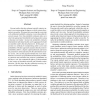Free Online Productivity Tools
i2Speak
i2Symbol
i2OCR
iTex2Img
iWeb2Print
iWeb2Shot
i2Type
iPdf2Split
iPdf2Merge
i2Bopomofo
i2Arabic
i2Style
i2Image
i2PDF
iLatex2Rtf
Sci2ools
ICDM
2006
IEEE
2006
IEEE
Converting Output Scores from Outlier Detection Algorithms into Probability Estimates
Current outlier detection schemes typically output a numeric score representing the degree to which a given observation is an outlier. We argue that converting the scores into well-calibrated probability estimates is more favorable for several reasons. First, the probability estimates allow us to select the appropriate threshold for declaring outliers using a Bayesian risk model. Second, the probability estimates obtained from individual models can be aggregated to build an ensemble outlier detection framework. In this paper, we present two methods for transforming outlier scores into probabilities. The first approach assumes that the posterior probabilities follow a logistic sigmoid function and learns the parameters of the function from the distribution of outlier scores. The second approach models the score distributions as a mixture of exponential and Gaussian probability functions and calculates the posterior probabilites via the Bayes’ rule. We evaluated the efficacy of both...
Related Content
| Added | 11 Jun 2010 |
| Updated | 11 Jun 2010 |
| Type | Conference |
| Year | 2006 |
| Where | ICDM |
| Authors | Jing Gao, Pang-Ning Tan |
Comments (0)

